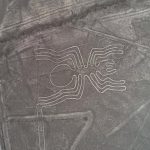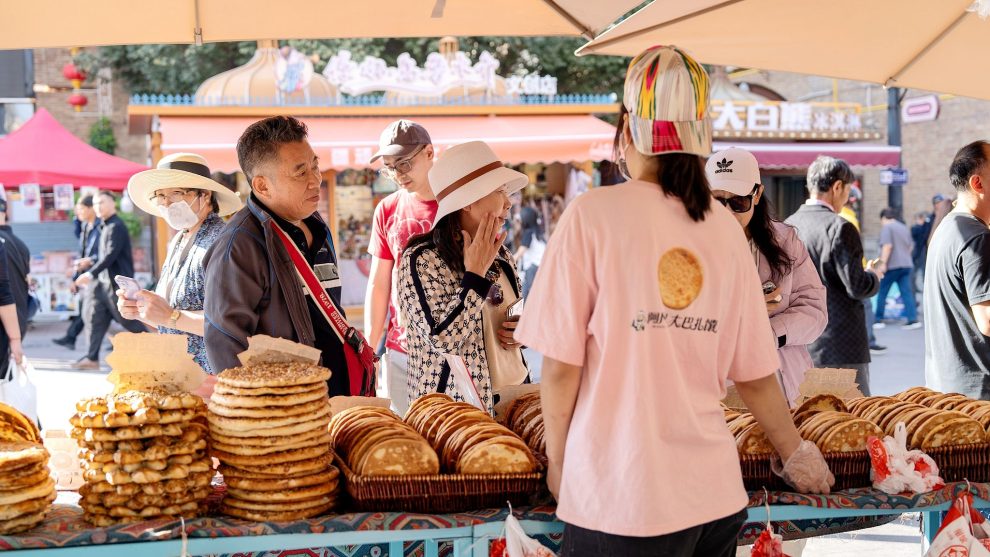In the Xinjiang Uygur Autonomous Region, located in northwest China, the flatbread known as naan is more than just a food. This is a fundamental part of daily life for ethnic groups in the region. Baked bread has become a symbol of Xinjiang’s cultural heritage, and its popularity is increasing, especially among tourists visiting the city of Urumqi. In recent years, naan has caught the attention of visitors looking to experience local cuisine, especially at the Xinjiang International Grand Bazaar.
For people of various ethnicities in Xinjiang, naan is not just a food but has become an essential part of their daily life.
In Urumqi, the capital of the region, there are numerous shops and stalls that produce and sell this bread, making it an easily accessible food. However, for many tourists coming from other parts of China, especially the eastern regions, naan represents a novelty and they are often attracted by its aroma and appearance. This food is especially common to find during holidays and events such as Chinese National Day.
Before this celebration, the stalls near the International Grand Bazaar are filled with tourists looking to taste naan. This bread, known as Uyghur flatbread, is one of the most beloved snacks in the region and has a history dating back centuries.
About a dozen years ago, almost every family in Xinjiang had a naan oven at home. However, today its production has been industrialized, becoming an important source of income for many local families.
Characteristics of Uyghur naan
Uyghur naan is a type of flatbread characterized by its soft and spongy texture, with a slightly crispy bottom. Its flavor is subtly sweet and smoky, which is due to cooking in a traditional oven called tandoor, which uses charcoal or wood as fuel. The basic ingredients of naan include wheat flour, water, yogurt, yeast and salt, although it is often enriched with milk or butter.
There are many variations of naan, some of which may include garlic, chive or cheese fillings. In Xinjiang, it is common for naan to be decorated with sesame seeds or onion, which adds extra flavor and texture.
How to make homemade naan
Ingredients
- For the dough:
- 2 cups of wheat flour
- 1/2 cup of natural yogurt
- 1/2 cup warm water
- 1 teaspoon sugar
- 1 teaspoon salt
- 1 teaspoon dry yeast
- 1 tablespoon oil (optional)
- The dressing (optional):
- melted butter
- chopped garlic
- sesame seeds
- Chopped chives
- Activate the yeast:
- In a small bowl, mix the warm water, sugar and dry yeast. Let sit for about 5-10 minutes, until the mixture is foamy.
- Mix the ingredients:
- In a large bowl, combine the flour and salt. Make a well in the center and add the yogurt, yeast mixture and oil (if using).
- Knead the dough:
- Mix everything until a dough forms. Then, knead for about 5-7 minutes on a floured surface, until the dough is smooth and elastic. If the dough is sticky, you can add a little more flour.
- Ferment the dough:
- Place the dough in a lightly greased bowl, cover with a damp cloth or plastic wrap, and let it rest in a warm place for about 1-2 hours, or until it has doubled in size.
- Form the loaves:
- Once the dough has risen, divide it into 6-8 portions. Shape each portion into a ball, then roll out with a rolling pin to a thickness of about 1/4 inch.
- Cook the naan:
- Heat a large skillet or griddle over medium-high heat. If you have a tandoor oven, even better! Place the naan in the hot pan and cook for 1-2 minutes, or until bubbles start to appear on the surface. Then, flip the naan and cook on the other side for a further 1-2 minutes, until golden and cooked through.
- Add toppings (optional):
- If desired, mix melted butter with minced garlic and brush over hot naan. You can also sprinkle sesame seeds or chopped chives.
- Serve:
- Serve the naan hot with your favorite dishes, such as curries, or simply enjoy it on its own.
Tips
- You can experiment with different types of flour, such as whole wheat flour, or add herbs and spices to the dough.
- Naan can also be cooked in the oven. Preheat the oven to its highest temperature and place the naan on a baking sheet lined with parchment paper.















Add Comment